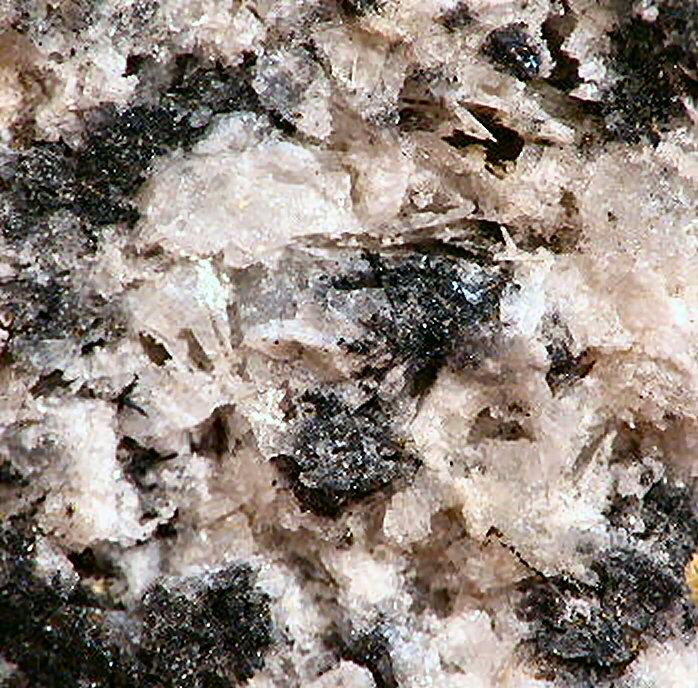Aguilarite
Aguilarit is a very rarely occurring mineral from the mineral class of " sulfides and sulfosalts ". It crystallizes in the orthorhombic crystal system with the chemical composition and forms Ag4SeS skeletal, pseudododekaedrische pseudocubic pseudooctahedral or crystals, but also bulky mineral aggregates and adhesions Akanthit or Naumannite.
Fresh crystal faces shine in a bright, metallic lead gray. Exposed to ambient air, however, this run after a while black.
Etymology and history
Was first discovered Aguilarit in the " San Carlos Mine" at La Luz in the Mexican state of Guanajuato and described in 1891 by Frederick Augustus Genth, who named the mineral after Señor Ponciano Aguilar ( 1853-1935 ), the manager of the type locality " San Carlos Mine".
Classification
In the now outdated but still in use 8th edition of the mineral classification by Strunz the Aguilarit belonged to the mineral class of " sulfides and sulfosalts " and then to the Department of " sulfides with the molar ratio of metal: sulfur, selenium, tellurium > 1:1", where he together with acanthite, argentite, Benleonardit, Cervelleit, Empressit, hessite, Chenguodait (IMA2004 - 042A ), Naumannite, Tsnigriit and Stützit the unnamed group II/B.05 formed.
The 9th edition used since 2001 and valid by the International Mineralogical Association (IMA ) of the Strunz'schen Mineral classification assigns the Aguilarit also in the class of " sulfides and sulfosalts " and there in the department of "Metal Sulfides, M: S> 1: 1 ( mainly 2: 1) " a. This division, however, is further subdivided according to the nature of the cations involved, so that the mineral is found according to its composition in the subdivision " with copper ( Cu), silver (Ag ) and / or gold ( Au) " where there is only together with Naumannite forms the unnamed group 2.BA.30b.
The classification of minerals according to Dana assigns the Aguilarit in the class of " sulfides and sulfosalts " and there in the department of " sulfide minerals ." Here he is with acanthite and Naumannite in the " Akanthitgruppe " with the system no. 02.04.01 within the subdivision " 02.04 sulfides - tellurides and selenides, including - with the composition AmBnXp, with (m n): p = 2:1 " to find.
Education and Locations
Aguilarit formed at relatively low temperatures in hydrothermal, silver and selenium-rich but low-sulfur deposits. Accompanying minerals include acanthite, calcite, Naumannite, Proustite, Pearceit, quartz, silver and stephanite.
Worldwide, Aguilarit so far (as of 2011 ) can be detected at about 60 localities. The most developed and up to 3 cm in length and the largest crystal finds were made across its type locality " San Carlos Mine" (La Luz ) and Chontalpan ( Guerrero ), but also in the Peñafiel mine in Guanajuato, which is also at La Luz located " Santa Rita mine ," the " Nino Perdido Mine" at Nayal and the " Flores de Maria Mine" at Rayas (all in the state of Guanajuato ) was found Aguilarit.
Other localities are Jagué (La Rioja in Argentina ); Hubei, the Autonomous Region of Inner Mongolia and Sichuan in China; Bohemia and Moravia in the Czech Republic; the Indonesian islands of Java and Sumatra; the Japanese islands of Hokkaido, Honshu and Kyushu; the North Island of New Zealand; the Far Eastern Federal District in Russia, the Kyzyl Kum desert in Uzbekistan and the regions of Colorado, Idaho, Nevada, Utah and Washington in the United States (USA).
Crystal structure
Aguilarit crystallizes in the orthorhombic space group P212121 with lattice parameters a = 4.33 Å; b = 7.09 Å and c = 7.76 Å and two formula units per unit cell.










